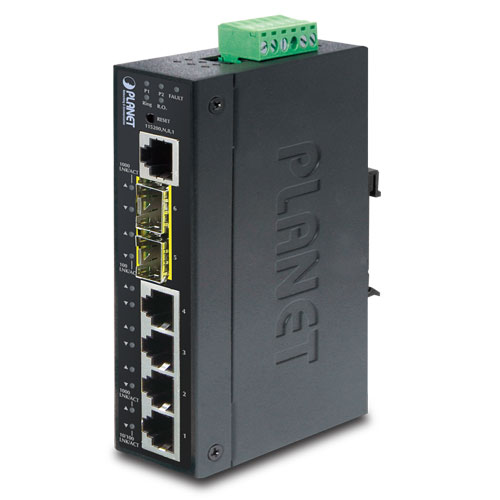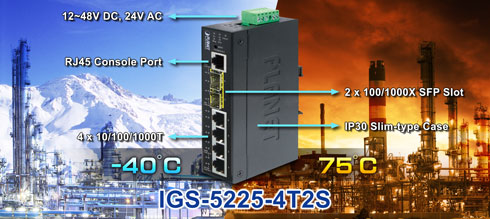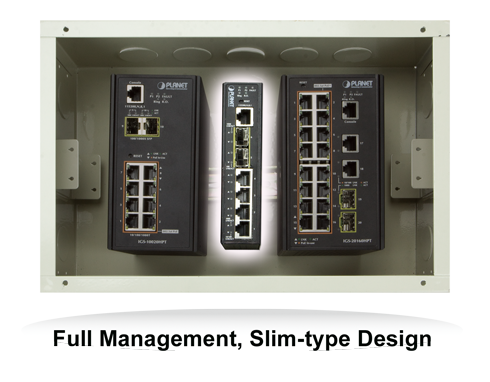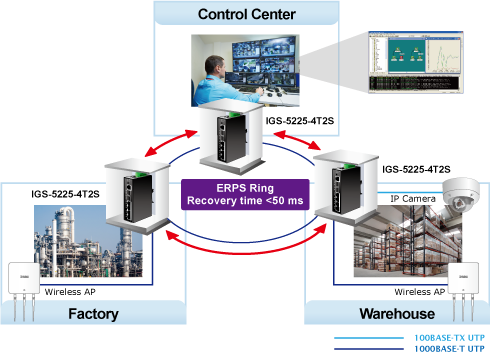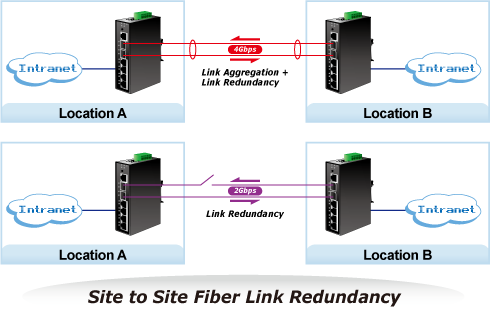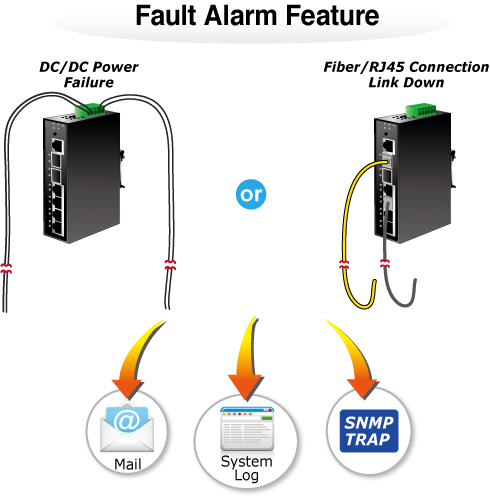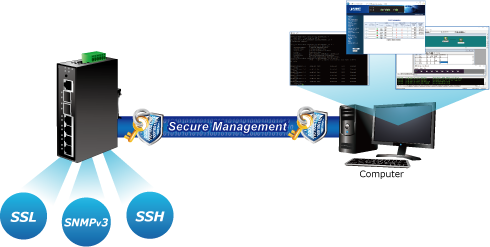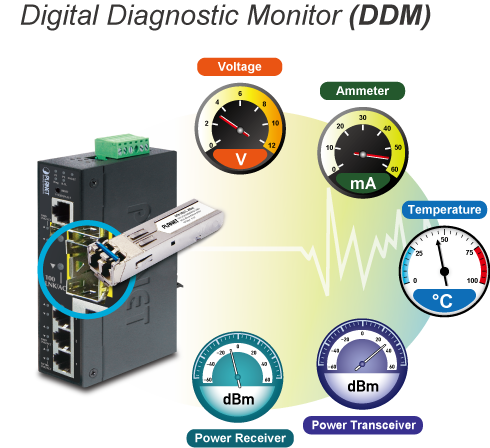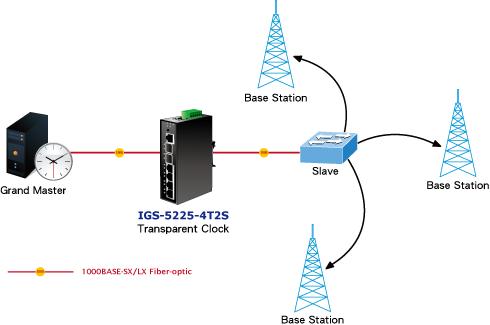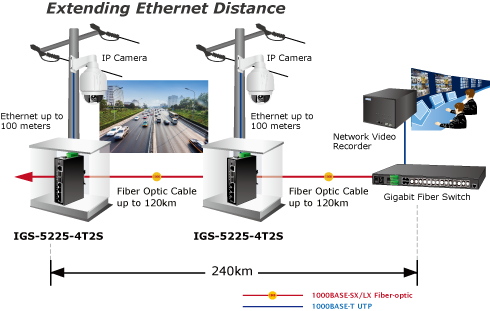IGS-5225-4T2S - Industrial L2+ 4-Port 10/100/1000T + 2-Port 100/1000X SFP Managed Switch
Click Image for Gallery
Overview
| An Ideal Fiber Switch with Limited Space PLANET IGS-5225-4T2S is the smallest, fully-managed Gigabit fiber switch in the industrial networking industry that features 4 10/100/1000Mbps copper ports, 2 100/1000X SFP ports and redundant power system in an IP30 rugged but compact-sized case, can be installed in any difficult environment without space limitation. Within such slim enclosure, it provides user-friendly yet advanced IPv6/IPv4 management interfaces, abundant L2/L4 switching functions and Layer 3 static routing capability. The IGS-5225-4T2S can operate stably under the temperature range from -40 to 75 degrees C and allows either DIN rail or wall mounting for efficient use of cabinet space. With 2 dual-speed SFP fiber slots, it can be flexibly applied to extend the connection distance. |
| Redundant Ring, Fast Recovery for Critical Network Applications The IGS-5225-4T2S supports redundant ring technology and features strong, rapid self-recovery capability to prevent interruptions and external intrusions. It incorporates advanced ITU-T G.8032 ERPS (Ethernet Ring Protection Switching) technology, Spanning Tree Protocol (802.1s MSTP), and redundant power input system into customer’s industrial automation network to enhance system reliability and uptime in harsh factory environments. In a certain simple Ring network, the recovery time of data link can be as fast as 20ms. |
| SMTP/SNMP Trap Event Alert The IGS-5225-4T2S provides event alert function to help to diagnose the abnormal device owing to whether or not there is a break of the network connection, or the rebooting response. Effective Alarm Alert for Better Protection The IGS-5225 series supports a Fault Alarm feature which can alert the users when there is something wrong with the switches. With this ideal feature, the users would not have to waste time finding where the problem is. It will help to save time and human resource. |
| Layer 3 IPv4 and IPv6 Software VLAN Routing for Secure and Flexible Management To help customers stay on top of their businesses, the IGS-5225 series not only provides ultra high transmission performance and excellent Layer 2 technologies, but also IPv4/IPv6 software VLAN routing feature which allows to crossover different VLANs and different IP addresses for the purpose of having a highly-secure, flexible management and simpler networking application. Robust Layer 2 Features The IGS-5225 series can be programmed for advanced switch management functions such as dynamic port link aggregation, Q-in-Q VLAN, private VLAN, Rapid Spanning Tree Protocol, Layer 2 to Layer 4 QoS, bandwidth control and IGMP snooping. The IGS-5225 series provides 802.1Q tagged VLAN, and the VLAN groups allowed will be maximally up to 255. Via aggregation of supporting ports, the IGS-5225-4T2S allows the operation of a high-speed trunk combining multiple ports. It enables a maximum of up to 10 trunk groups with 8 ports per trunk group, and supports fail-over as well. |
| Efficient Management For efficient management, the IGS-5225 Managed Ethernet Switch series is equipped with console, Web and SNMP management interfaces. With the built-in Web-based management interface, the IGS-5225 series offers an easy-to-use, platform-independent management and configuration facility. For text-based management, the IGS-5225 series can be accessed via Telnet and the console port. Moreover, it also offers secure remote management via any standard-based management software by supporting SNMPv3 connection which encrypts the packet content at each session. |
| Powerful Security The IGS-5225 series offers comprehensive Layer 2 to Layer 4 Access Control List (ACL) for enforcing security to the edge. It can be used to restrict network access by denying packets based on source and destination IP address, TCP/UDP ports or defined typical network applications. Its protection mechanism also comprises 802.1X Port-based and MAC-based user and device authentication. With the private VLAN function, communication between edge ports can be prevented to ensure user privacy. The network administrators can now construct highly-secure corporate networks with considerably less time and effort than before. Flexibility and Extension Solution The additional two mini-GBIC slots built in the IGS-5225-4T2S support dual speed, 100BASE-FX and 1000BASE-SX/LX SFP (Small Form-factor Pluggable) fiber-optic modules, meaning the administrator now can flexibly choose the suitable SFP transceiver according to not only the transmission distance but also the transmission speed required. The distance can be extended from 550 meters (multi-mode fiber) to 10/50/70/120 kilometers (single-mode fiber or WDM fiber). They are well suited for applications within the enterprise data centers and distributions. Intelligent SFP Diagnosis Mechanism The IGS-5225 series supports SFP-DDM (Digital Diagnostic Monitor) function that greatly helps network administrator to easily monitor real-time parameters of the SFP, such as optical output power, optical input power, temperature, laser bias current, and transceiver supply voltage. |
| 1588 Time Protocol for Industrial Computing Networks The IGS-5225 series is ideal for telecom and Carrier Ethernet applications, supporting MEF service delivery and timing over packet solutions for IEEE 1588 and synchronous Ethernet. |
| Modbus TCP provides Flexible Network Connectivity for Factory Automation With the supported Modbus TCP/IP protocol, the IGS-5225 series can easily integrate with SCADA systems, HMI systems and other data acquisition systems in factory floors. It enable administrators to remotely monitor the industrial Ethernet switch’s operating information, port information and communication status, thus easily achieving enhanced monitoring and maintenance of the entire factory. |
Features
Physical Port
- 4 10/100/1000BASE-T Gigabit Ethernet RJ45 ports
- 2 100/1000BASE-X mini-GBIC/SFP slots for SFP type auto detection
- One RJ45 console interface for basic management and setup
Industrial Case and Installation
- IP30 metal case
- DIN rail and wall-mount design
- 12~48V DC, redundant power with polarity reverse protect function
- 24V AC power input acceptable
- Supports 5000V DC Ethernet ESD protection
- -40 to 75 degrees C operating temperature
Layer 2 Features
- Prevents packet loss with back pressure (half-duplex) and IEEE 802.3x pause frame flow control (full-duplex)
- High performance of Store-and-Forward architecture, and runt/CRC filtering eliminates erroneous packets to optimize the network bandwidth
- Storm Control support
- - Broadcast/Multicast/Unicast
- Supports VLAN
- - IEEE 802.1Q tagged VLAN - Up to 255 VLANs groups, out of 4094 VLAN IDs- Provider Bridging (VLAN Q-in-Q) support (IEEE 802.1ad)
- - Private VLAN Edge (PVE) - Protocol-based VLAN- MAC-based VLAN- Voice VLAN
- Supports Spanning Tree Protocol
- - IEEE 802.1D Spanning Tree Protocol (STP)
- - IEEE 802.1w Rapid Spanning Tree Protocol (RSTP)
- - IEEE 802.1s Multiple Spanning Tree Protocol (MSTP), spanning tree by VLAN
- - BPDU Guard
- Supports Link Aggregation
- - 802.3ad Link Aggregation Control Protocol (LACP)
- - Cisco ether-channel (static trunk)
- - Maximum 4 trunk groups with 4 ports per trunk group
- - Up to 8Gbps bandwidth (duplex mode)
- - Provides port mirror (1-to-1)
- Port mirroring to monitor the incoming or outgoing traffic on a particular port
- Loop protection to avoid broadcast loopsv
- Supports ERPS (Ethernet Ring Protection Switching)
Layer 3 IP Routing Features
- Supports maximum 32 static routes and route summarization
Quality of Service
- Ingress Shaper and Egress Rate Limit per port bandwidth control
- 8 priority queues on all switch ports
- Traffic classification
- - IEEE 802.1p CoS
- - IP TOS/DSCP/IP precedence
- - IP TCP/UDP port number
- - Typical network application
- Strict priority and Weighted Round Robin (WRR) CoS policies
- Supports QoS and In/Out bandwidth control on each port
- Traffic-policing policies on the switch port
- DSCP remarking
Multicast
- Supports IGMP snooping v1, v2 and v3
- Supports MLD snooping v1 and v2
- Querier mode support
- IGMP snooping port filtering
- MLD snooping port filtering
- MVR (Multicast VLAN Registration)
Security
- IEEE 802.1X Port-based/MAC-based network access authentication
- Built-in RADIUS client to cooperate with the RADIUS servers
- TACACS+ login users access authentication
- RADIUS/TACACS+ users access authentication
- IP-based Access Control List (ACL)
- MAC-based Access Control List
- Source MAC/IP address binding
- DHCP snooping to filter distrusted DHCP messages
- Dynamic ARP Inspection discards ARP packets with invalid MAC address to IP address binding
- IP Source Guard prevents IP spoofing attacks
- IP address access management to prevent unauthorized intruder
Management
- Switch Management Interfaces
- - Console/Telnet Command Line Interface
- - Web switch management
- - SNMP v1 and v2c switch management
- - SSH/SSL and SNMP v3 secure access
- Four RMON groups (history, statistics, alarms, and events)
- IPv6 IP address/NTP/DNS management
- Built-in Trivial File Transfer Protocol (TFTP) client
- BOOTP and DHCP for IP address assignment
- Firmware upload/download via HTTP/TFTP
- DHCP Relay
- DHCP Option 82
- User Privilege levels control
- Network Time Protocol (NTP)
- Link Layer Discovery Protocol (LLDP)
- SFP-DDM (Digital Diagnostic Monitor)
- Cable diagnostic technology provides the mechanism to detect and report potential cabling issues
- Reset button for system reboot or reset to factory default
- PLANET Smart Discovery Utility for deployment management
Applications
| Model that Withstands Harsh Operation The IGS-5225-4T2S is made to withstand any harsh operation in such environments as traffic control cabinets, factory floors, and indoor and outdoor locations where temperatures are extremely high or low. With a non-blocking design and compact size, the installation of the IGS-5225-4T2S is easy and helpful to build a Gigabit high-bandwidth switched network quickly. |
Specifications
| Hardware Specifications | |
| Copper Ports | 4 10/100/1000BASE-T RJ45 auto-MDI/MDI-X ports |
| SFP/mini-GBIC Slots | 2 1000BASE-SX/LX/BX SFP interfaces (Port-5 to Port-6) Compatible with 100BASE-FX SFP |
| Console | 1 x RJ45-to-RS232 serial port (115200, 8, N, 1) |
| Switch Architecture | Store-and-Forward |
| Switch Fabric | 12Gbps/non-blocking |
| Throughput (packet per second) | 8.9Mpps@ 64 bytes packet |
| Address Table | 8K entries, automatic source address learning and aging |
| Shared Data Buffer | 4Mbits |
| Flow Control | IEEE 802.3x pause frame for full-duplex Back pressure for half-duplex |
| Jumbo Frame | 9Kbytes |
| Reset Button | < 5 sec: System reboot > 5 sec: Factory default |
| ESD Protection | 5KV DC |
| Enclosure | IP30 metal case |
| Installation | DIN rail kit and wall-mount kit |
| Connector | Removable 6-pin terminal block for power input Pin 1/2 for Power 1, Pin 3/4 for fault alarm, Pin 5/6 for Power 2 |
| Alarm | One relay output for power failure. Alarm relay current carry ability: 1A @ 24V DC |
| LED Indicator | System: Power 1 (Green) Power 2 (Green) Fault Alarm ( Red ) Ring (Green) Ring Owner (Green) Per 10/100/1000T RJ45 Ports: 10/100Mbps LNK/ACT (Orange) 1000 LNK/ACT (Green) Per SFP Interface: 100 LNK/ACT (Orange) 1000 LNK/ACT (Green) |
| Dimensions (W x D x H) | 32 x 87x 135 mm |
| Weight | 456g |
| Power Requirements | Dual 12~48V DC 24V AC |
| Power Consumption | Max. 6.3 watts/21.6 BTU (Power on without any connection) Max. 8.5 watts/29.2 BTU (Full loading) |
| Layer 2 Function | |
| Basic Management Interfaces | Console; Telnet; Web browser; SNMP v1, v2c |
| Secure Management Interfaces | SSH, SSL, SNMP v3 |
| Port Configuration | Port disable/enable Auto-negotiation 10/100/1000Mbps full and half duplex mode selection Flow control disable/enable Power saving mode control |
| Port Status | Display each port’s speed duplex mode, link status, flow control status, auto negotiation status, trunk status |
| Port Mirroring | TX/RX/both 1 to 1 monitor |
| VLAN | 802.1Q tagged based VLAN, up to 255 VLAN groups Q-in-Q tunneling Private VLAN Edge (PVE) MAC-based VLAN Protocol-based VLAN Voice VLAN MVR (Multicast VLAN Registration) Up to 255 VLAN groups, out of 4094 VLAN IDs |
| Link Aggregation | IEEE 802.3ad LACP/static trunk Supports 4 trunk groups with 4 ports per trunk group |
| QoS | Traffic classification based, strict priority and WRR 8-level priority for switching - Port number - 802.1p priority - 802.1Q VLAN tag - DSCP/TOS field in IP packet |
| IGMP Snooping | IGMP (v1/v2/v3) snooping, up to 255 multicast groups IGMP querier mode support |
| MLD Snooping | MLD (v1/v2) snooping, up to 255 multicast groups MLD querier mode support |
| Access Control List | IP-based ACL/MAC-based ACL Up to 123 entries |
| Bandwidth Control | Per port bandwidth control Ingress: 500Kb~1000Mbps Egress: 500Kb~1000Mbps |
| SNMP MIBs | RFC 1213 MIB-II IF-MIB RFC 1493 Bridge MIB RFC 1643 Ethernet MIB RFC 2863 Interface MIB RFC 2665 Ether-Like MIB RFC 2819 RMON MIB (Groups 1, 2, 3 and 9) RFC 2737 Entity MIB RFC 2618 RADIUS Client MIB RFC 2933 IGMP-STD-MIB RFC 3411 SNMP-Frameworks-MIB IEEE 802.1X PAE LLDP MAU-MIB |
| Layer 3 Function | |
| IP Interfaces | Max. 8 VLAN interfaces |
| Routing Table | Max. 32 routing entries |
| Routing Protocols | IPv4 software static routing IPv6 software static routing |
| Standards Conformance | |
| Regulatory Compliance | FCC Part 15 Class A, CE |
| Stability Testing | IEC60068-2-32 (free fall) IEC60068-2-27 (shock) IEC60068-2-6 (vibration) |
| Standards Compliance | IEEE 802.3 10BASE-T IEEE 802.3u 100BASE-TX/100BASE-FX IEEE 802.3z Gigabit SX/LX IEEE 802.3ab Gigabit 1000T IEEE 802.3x flow control and back pressure IEEE 802.3ad port trunk with LACP IEEE 802.1D Spanning Tree Protocol IEEE 802.1w Rapid Spanning Tree Protocol IEEE 802.1s Multiple Spanning Tree Protocol IEEE 802.1p Class of Service IEEE 802.1Q VLAN tagging IEEE 802.1X Port Authentication Network Control IEEE 802.1ab LLDP RFC 768 UDP RFC 793 TFTP RFC 791 IP RFC 792 ICMP RFC 2068 HTTP RFC 1112 IGMP v1 RFC 2236 IGMP v2 |
| Environment | |
| Operating Temperature | -40 ~ 75 degrees C |
| Storage Temperature | -40 ~ 85 degrees C |
| Humidity | 5 ~ 95% (non-condensing) |
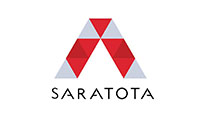



-200x200.jpg)
-200x200.jpg)








